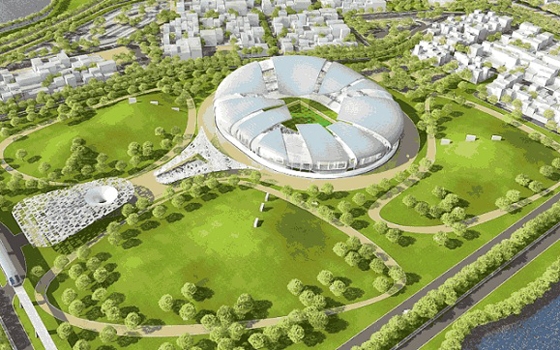Of the 1236 green buildings in the GCC countries, 16% are located in Qatar, which according to a recent report by Ventures Middle East stands at number two in the region’s green building market. The country is leading the Gulf with its work on the Global Sustainability Assessment System (GSAS) – a certification system similar to that of Leadership in Energy and Environmental Design (LEED). Doha is also on its way to marking a world record with the development of the Msheireb Downtown Project which houses the largest collection of green buildings, 100 in total.
Of the current 200 green buildings in Qatar, about one quarter are complete. There are 50 completed and certified, 100 with Msheireb properties almost in completion, and many other developments in Qatar Foundation. In Lusail city, many projects in design and construction have already started, with further growth in governmental projects and private projects which use a combination of LEED and GSAS system.
Moreover, the GSAS system will establish green building standards to which all government buildings will have to conform by 2016. Later, all new commercial and residential buildings will be brought into the new regime. In two years’ time, mandatory regulations will increase the number of projects. The optional period will give a chance to companies to enter that market, because sooner or later it will be mandatory
Actually, Qatar is well on its way to bringing its own green roadmap and a green directory. On the research and development side, it houses a Passivhaus in a property of Barwa Real Estate Development. All this was not there a few years ago, but recently the Qatar Green Building Council (QGBC), part of the World Green Building Council, has played a crucial role in promoting sustainability. The QGBC has been working on spreading awareness about sustainability in the country’s construction sector through a series of workshops, and has been an active force behind recent green projects in Qatar.
While a number of credentials add to the sustainability features of a green building, it is not unusual for various construction markets to prioritize some elements over the other, depending on environmental concerns particular to the region. While the LEED system has generic standards for green buildings as a whole, it also has specific standards for every country, much like the GSAS. In Qatar, there are 10 priority credits, six of them about water, which is the most important element in green buildings followed by energy.
While encouraging the use of recycled water within green buildings addresses the issue of water scarcity, better insulation systems prevent temperature flow, hence reducing energy consumption in air-conditioning and ventilation systems.
However, before water and energy efficient systems are set up and running, other environmental concerns remain critical to Qatar’s construction activity. One such concern relates to the management of construction waste produced as a result of Qatar’s ongoing construction and infrastructure boom.
Eventually, taking Qatar’s construction industry towards a sustainable future will not merely be a matter of raising concerns and awareness. Part of the movement also lies in facilitating the stakeholders towards this end. In a recent move, QGBC announced the launch of Qatar’s first green directory for the construction industry. Scheduled for release this year, the directory will work as a reference point featuring a list of companies providing green solutions, both in services and materials.
With the growing focus on green buildings in the Gulf, Qatar’s construction market sentiment hints towards legislation, which will make green buildings mandatory. First introduced in the 2010 edition of Qatar Construction Specifications (QCS), green buildings have been further elaborated in QCS 2014. Under a number of categories, the document states minimum requirements and the buildings to which these would be applicable. The eight building typologies required to include green credentials include commercial, light industry, government, health centers, railways, sports, mosques and education buildings. The criteria for these buildings under QCS 2014 include support of national economy, cultural identity and heritage, recycling management, regional material, thermal comfort, natural ventilation, mechanical ventilation, low-emitting materials, energy demand performance, energy delivery performance and water consumption.
While the goal of GSAS is similar to that of the LEED systems, the methodologies are different in a sense that the former selects the items that are more suitable to Qatar. Similarly, the applicability of GSAS is spread across a diverse range of projects. There is a GSAS for mosques, which we don’t have in LEED. Then, there is GSAS for rails, for example, and other such projects that are more relevant to the Arabian countries.
The choice between LEED and GSAS depends on the developer’s strategic focus. Qatar Foundation goes with LEED, and some other organizations go with GSAS. World Cup stadiums are aiming for dual certifications.
In context of the 2022 World Cup, considering FIFA’s elusive standards on sustainable stadiums, it makes sense for Qatar to take a proactive strategy through dual certification that ensures the highest number of green credentials within the stadiums under construction for the 2022 World Cup.
Because of high-quality materials, the initial costs of green buildings are usually high. However, the total energy consumption will be reduced, thereby lowering the operational costs and improving indoor quality. For developers, the cost-effectiveness of constructing a green building is still a question mark, even though there is no doubt about the environmental benefits and lower operational costs linked to green construction. However, as Qatar moves closer to legislating green buildings, a number of grey areas need to be addressed. For instance, while the rule for green construction will be straightforward for buildings in the design and planning stage, to what extent will green legislation apply to projects under construction, near completion, waiting for handover and crucially major existing buildings? These, among others, are some questions only time will tell.
Ifpinfo
13 March

























































